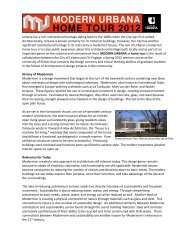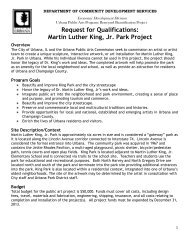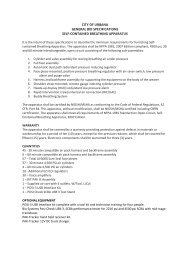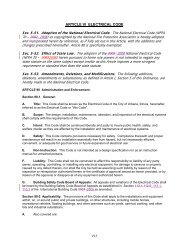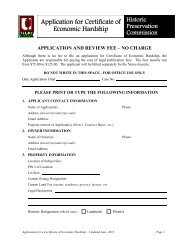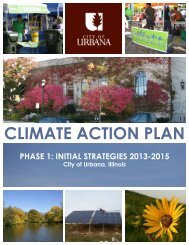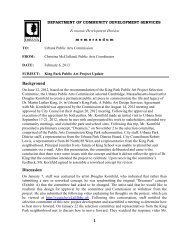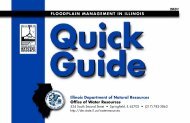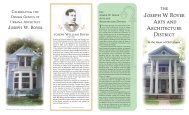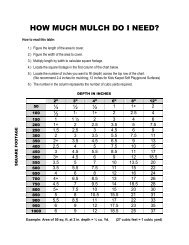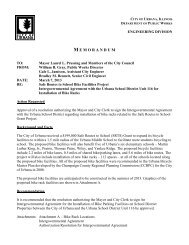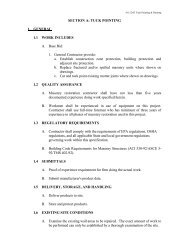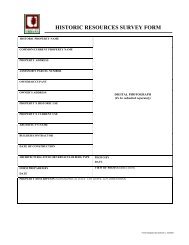RFP #1112-05 Bid Specifications - City of Urbana
RFP #1112-05 Bid Specifications - City of Urbana
RFP #1112-05 Bid Specifications - City of Urbana
Create successful ePaper yourself
Turn your PDF publications into a flip-book with our unique Google optimized e-Paper software.
Street and Public Property Tree Inventory and Tree Inventory Data Management S<strong>of</strong>tware<br />
<strong>City</strong> <strong>of</strong> <strong>Urbana</strong><br />
Request for Proposals <strong>RFP</strong> <strong>#1112</strong>-<strong>05</strong><br />
Page 5 <strong>of</strong> 34<br />
‣ Stump Removal. This category indicates a stump that should be removed.<br />
any stump 4”or greater in diameter be specified for removal.<br />
‣ Plant Tree. During the inventory, vacant planting sites will be identified<br />
by street, address and site number. The size <strong>of</strong> the site is designated as<br />
small, medium, or large (indicating the ultimate size that the tree will<br />
attain), depending on the growing space available and the presence <strong>of</strong><br />
overhead wires. Planting sites are determined based on 40 foot spacing<br />
from existing trees, and minimums <strong>of</strong> 15 feet from driveway approaches<br />
and street lights, 75 feet from intersections, 35 feet from overhead<br />
electrical conductors/poles and 5 feet from all other utility structures.<br />
7. Secondary Maintenance Need. The following secondary maintenance needs will<br />
be determined based on ANSI A300 standard specifications:<br />
‣ Raise. Trees requiring pruning to remove low branches that interfere with<br />
vehicular, pedestrian or bicycle traffic and their respective site lines. The<br />
following clearance standards shall be used; 9 feet over sidewalks and<br />
public/park turf areas that need grounds maintenance equipment access, 16<br />
feet over roads for Traffic clearance, and 10 feet over driveways and<br />
buildings.<br />
‣ Reduce. Selective pruning to decrease height and/or spread <strong>of</strong> the crown in<br />
order to provide clearance for special needs such as electric utilities and<br />
lighting.<br />
‣ Thin. The selective removal <strong>of</strong> water sprouts, epicormic branches, and live<br />
branches to reduce density.<br />
‣ Utility. Selective pruning to prevent the loss <strong>of</strong> service, comply with<br />
mandated clearance laws, prevent damage to equipment, avoid access<br />
impairment, and uphold the intended usage <strong>of</strong> the facility/utility space.<br />
‣ Restoration. Selective pruning to improve the structure, form, and<br />
appearance <strong>of</strong> trees that have been severely headed, vandalized, or<br />
damaged.<br />
‣ None. No secondary maintenance is recommended for the tree. This will<br />
be used as the default value when Primary Maintenance equals Removal,<br />
Stump Removal, or Plant Tree.<br />
8. Risk Assessment. A risk rating will be assigned using an assessment protocol<br />
based on the USDA Forest Service Community Tree Risk Rating System.<br />
‣ Probability <strong>of</strong> Failure (1 – 4 points). Identifies the most likely failure and<br />
rates the likelihood that the structural defect(s) will result in failure based<br />
on observed, current conditions.<br />
‣ Size <strong>of</strong> Defective Part (1 – 3 points). Rates the size <strong>of</strong> the part most likely<br />
to fail. If the trunk is the part most likely to fail, tree will recommended<br />
for removal and the DBH value will be used for the size <strong>of</strong> the defective<br />
part.



